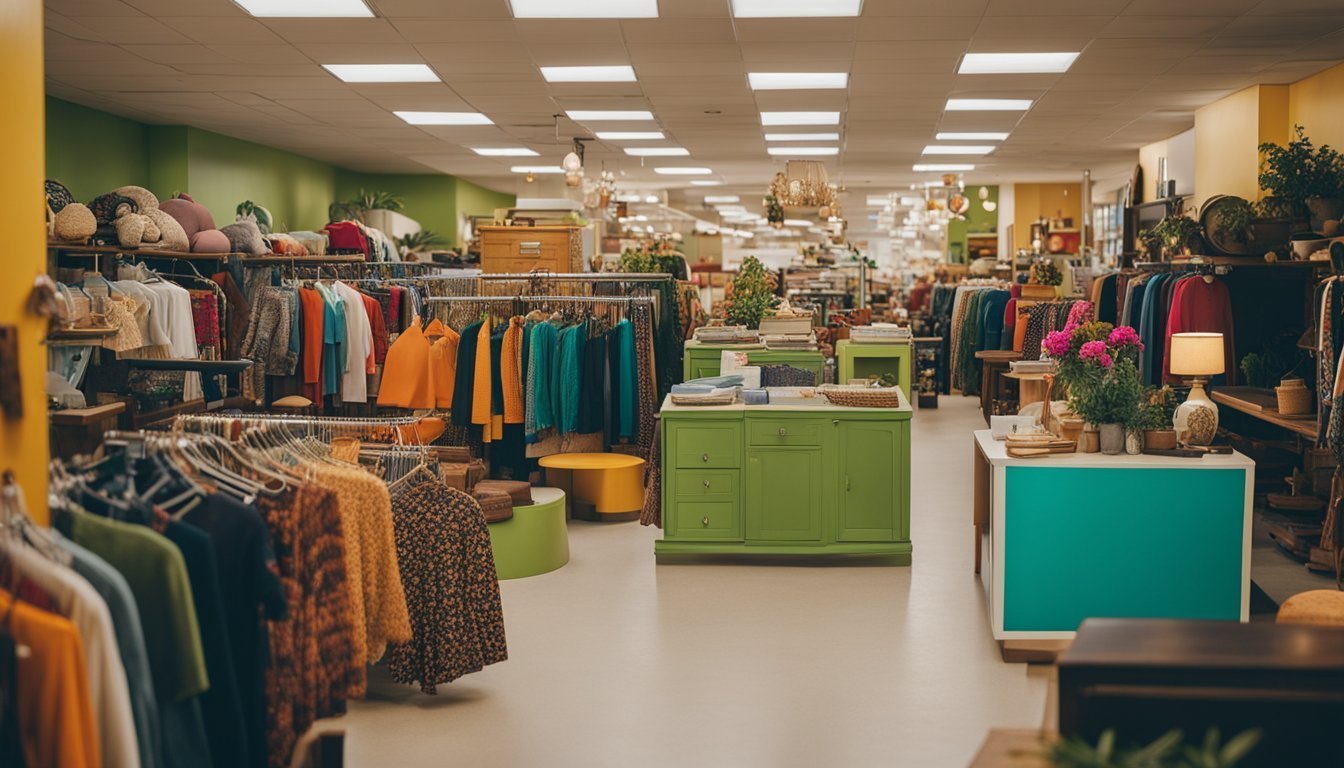What Is Thrift Store Flipping?
Thrift store flipping is about capitalizing on the gap between how much you pay for an item and what it can be sold for.
The trick to succeeding in this venture is to spot goods that are undervalued in thrift environments but hold greater worth in the resale market.
Successful flippers take many aspects into account—brand recognition, condition, scarcity, and consumer interest all play a substantial role.
Prominent online marketplaces for reselling these gems include eBay and Poshmark.
Making Money with Thrift Store Finds
Earning a profit from this side hustle involves a well-defined process:
- Finding Items: Scour thrift shops, yard sales, and flea markets to discover items that can be flipped for a profit.
- Assessing Value: Research and evaluate the potential resale prices of items by comparing them with similar listings across different online platforms.
- Preparing the Goods: Boost the attractiveness of your finds by cleaning, repairing, or restoring them, and sharpen your negotiation skills to secure the best deals.
- Promoting Your Listings: Capture stunning photographs from multiple angles to showcase your products online.
Select the right platform for sales and craft thorough descriptions highlighting essential details like dimensions.
- Providing Stellar Service: Ensure quick responses to buyer inquiries and prioritize prompt packaging and shipping to foster a positive shopping experience.
Smart Strategies for Success
If you’re looking to maximize your flipping success, consider these pointers:
- Start with a Limited Budget: Begin small with funds you’re comfortable spending, focusing on items that pique your personal interest.
- Research Is Key: Knowing the potential resale values of goods can guide your purchasing choices wisely.
- Inspect Before You Buy: At yard sales, make sure that items are in reasonable shape, steering clear of those needing significant repairs.
- Identify Key Categories: Vintage apparel, collectible toys, and unique decorative pieces are often sought after, so keep an eye out for these.
Consider hunting for first editions of books or distinctive wooden furniture to amplify your potential gains.
Becoming a successful flipper often boils down to knowing your local landscape.
Utilize online tools to find thrift stores in your vicinity.
Google Maps can help you navigate user ratings and reviews, while Instagram can inspire your research.
Additionally, connecting with local flipping communities on social media can provide valuable insights and tips from experienced flippers.
Consider leveraging platforms that offer exclusive deals, such as the siteguru lifetime subscription offer, which can enhance your research capabilities and streamline your sourcing process.
By staying informed about local trends and building a network, you’ll be better equipped to maximize your profits in the flipping business.
Visit a range of stores to evaluate their quality and inventory.
Typically, thrift shops located in affluent areas offer better donations and competitive pricing.
To thrive in turning thrift finds into cash, sharpen your skills in evaluating items, understanding market trends, and analyzing consumer demand.
Keeping an eye on completed sales on platforms like Amazon and Etsy will give you a feel for current market values.
Participating in social media groups and connecting with influencers can further heighten your trend awareness.
An in-depth understanding of various product categories is crucial.
Being able to spot quality materials, esteemed brands, and manufacturing specifics will guide your buying decisions, alongside understanding local sales trends.
To improve your chances of scoring profitable items, keep these insights in mind:
- Seek Unique Items: Look for goods that are one-of-a-kind or display high craftsmanship.
Pieces with identifiable artist signatures are especially valuable.
- Master Vintage Items: Familiarize yourself with different styles and periods to differentiate genuine vintage from reproductions.
Authentic vintage clothing often showcases nostalgic brand tags.
- Focus on Recognizable Brands: The item’s condition significantly impacts its resale value.
Discontinued items or those from esteemed brands, particularly if well-maintained, can fetch higher prices.
Check out these categories that can lead to impressive profits:
- Designer Vintage Apparel: Always in high demand due to unique designs.
- Rare First Edition Books: Collectors are consistently on the lookout.
- Premium Kitchen Appliances: Known for durability and quality.
- Electronics from Trusted Brands: Often command high resale prices.
- Vintage Furniture: Mid-century modern pieces are particularly sought after.
- Collectible Toys: Nostalgic items capture buyers’ hearts.
- Musical Instruments: Renowned brands appreciate over time.
- Sports Equipment: Items like bicycles and golf gear are durable and maintain their worth.
- Photography Gear: Cameras and lenses consistently have a strong market.
- Luxury Handbags and Accessories: Typically retain their value well.
- Artworks: High aesthetic appeal can lead to substantial resale opportunities.
- Vinyl Records: Rare finds can be highly prized—ensure they are in good condition.
- Antique Jewelry: Unique attributes can significantly increase value.
- Quality Footwear: Designer shoes made from high-grade materials tend to sell quickly.
- Vintage Games and Puzzles: Evergreen nostalgia keeps demand high.
- Outdoor Equipment: Camping gear is often in great demand.
- Power Tools: Longevity makes them sought after.
- Distinct Home Decor: Aim for items that are both functional and visually appealing.
- Cookware: Quality kitchen tools are always marketable.
- Gardening Equipment: Consider their condition for better resale potential.
- Children’s Toys and Gear: Functionality and safety are key concerns.
- Craft Supplies: Always a steady demand for various crafting needs.
- Office Furniture: Demand continues to rise as more people work remotely.
- Collectible Coins and Stamps: Prioritize items based on rarity for better valuation.
Absolutely! If you have an eye for undervalued goods and can gauge market demand, profitability is within reach.
Yes, with the right strategies and sourcing abilities, many have transitioned this side hustle into full-time careers.
Popular categories include home decor, electronics, collectible items, brand-name clothing, and vintage furniture, all carrying strong resale potential.
Definitely.
You’ll need to report income from sales for tax purposes, and depending on local regulations, a business license might be necessary.
Familiarize yourself with shipping rules and consumer protection laws as well.
By applying these strategies and staying current on market trends, you can master the art of thrift store flipping, transforming hidden gems into profitable sales.
Source: Smallbiztrends


